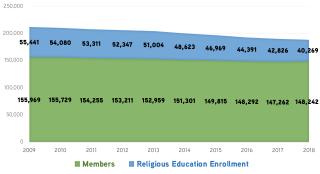Advertisement
For the first time since 2008, U.S. congregations in the Unitarian Universalist Association reported a membership increase in 2018. Although the decline each year from 2009 through 2017 was slight, and the increase in 2018 was only 980 members, the UUA is doing better than many similar religious groups in the United States.
Unfortunately, another trend in the congregational data continues to worry UU leaders. Religious education enrollment, which began dropping in 2002 even as membership was rising, continues to fall, with no sign of slowing down.
The UUA’s 1,012 congregations in the United States reported 148,242 members during the February 2018 annual certification process, up 0.67 percent from 147,262 in 2017. Counting the twenty-one international congregations and the non-geographic Church of the Larger Fellowship, the total membership of the UUA was 154,715 in 2018, up 0.78 percent from 153,522 last year.
Compared to some faith groups, that’s not bad. Mainline Protestant denominations—which share many demographic characteristics with the UUA, and most of which have embraced liberal positions in America’s culture wars—have seen precipitous losses in membership since the 1990s. The Presbyterian Church USA dropped 4.6 percent last year; the Episcopal Church declined 1.9 percent; the United Church of Christ lost 3 percent. But liberal churches are not the only ones in decline. Roman Catholic parishes have seen widespread closures, and even the Southern Baptist Convention, the largest Protestant denomination and largest Evangelical body in the United States, counts fewer members each year.
Gallup surveys show that many Americans are simply giving up church-going. The percentage of Americans who say they belong to a church or synagogue dropped from 61 to 54 percent over the last ten years. During that same period, weekly churchgoers dropped from 30 to 23 percent, while those who say they never attend a service rose from 16 to 27 percent of the population.
In that context, the fact that UU membership has declined only 4.95 percent over a decade may be a kind of good news. Still, U.S. congregations lost 7,727 members since 2009, and our religious education programs shrank by 15,172 children—a drop of 27.37 percent, more than five times the rate of membership decline.
Why, if membership remains relatively stable, is the number of children formally connected to our congregations falling so dramatically?
In part, the enrollment decline parallels a drop in the birthrate as Baby Boomers stopped giving birth in the mid-1990s. Parents born between 1965 and 1981 are part of a much smaller age cohort, Generation X; most children in many UU congregations now have Gen X parents. And millennials, the generation that is projected to outnumber Baby Boomers in 2019, are delaying having children longer than earlier generations.
But even as millennials have children of their own, they may not bring their kids to church. A 2014 study revealed that one-third of millennials are not affiliated with any religious community.
Church attendance may be losing out to competing demands on children’s time from sports or other activities, but surveys show declining rates of participation in those activities, too, except among upper-income families.
And our basic model may no longer work. In a 2017 paper published by the UUA’s New England Region called “The Death of Sunday School and the Future of Faith Formation,” Kim Sweeney argues that the classroom model no longer serves the faith formation needs of children, parents, or other adults. We need new models, she says: “Paying attention to the shifting needs of our families and children, releasing ourselves from the rigid structures of our past, and boldly experimenting to contribute to the evolution of faith formation may just be the spiritual task of our time.”
